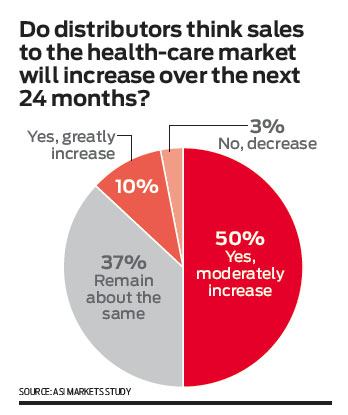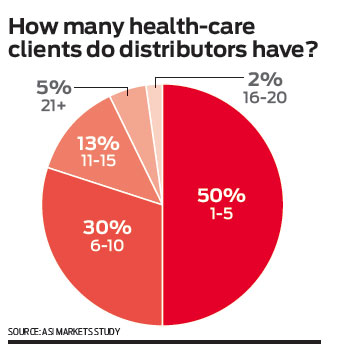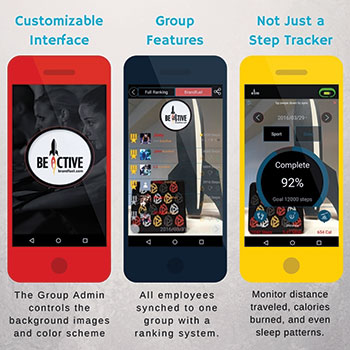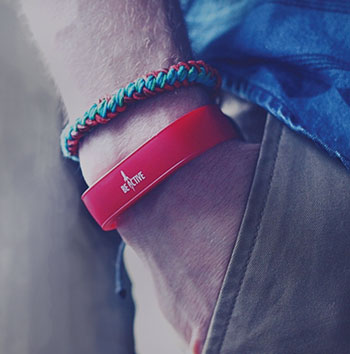Strategy July 11, 2016
How to Sell to the Health-Care Sector
If you’re only selling to traditional segments, you’re missing a big opportunity.
The health-care sector has morphed into a vast and varied scope of promotional business for sales reps, a far cry from simply hospitals, doctor and dentist offices that used to make up this market. The biggest change of late? The wellness boom.

Companies across all industries are experiencing the consequences of unhealthy workers, as obesity, diabetes, autoimmunity and other disease numbers climb. Many firms are taking proactive steps to help improve the lives of their employees, while also working to trim rising health insurance costs.
>> Related: 5 tips for cashing in on health care
The 2016 Aflac Workforces Report on small to midsize businesses shows 79% of employees now participate in their employers’ wellness programs. And, according to Aflac data, 53% of survey respondents would take part in a workplace-related exercise program if it lowered their health insurance cost.
While the momentum for this proactive approach is strenthening, many Americans are already sick, and traditional practices are spending more on advertising to hold market share against emerging alternative therapies like massage, yoga, chiropractic care, acupuncture and energy healing.
What does all this mean for the ad specialty industry? “Because of economic and societal changes, you have to be a true marketing consultant to really make it in today’s promotional landscape,” says Ron Williams, director of marketing at Fey Promotional Products (asi/54040). “Those who study the consumer trends and have learned how to integrate their products and services into those trends are the ones really cashing in.”
 Navigating an Evolving Market
Navigating an Evolving Market
Industry veterans have watched health-care trends come and go (remember Big Pharma?), but the wellness push appears to have a solid foothold. After all, wellness affects every single person, as well as the health of companies and organizations. Gone are the days when health-care promotions were driven by candy striper uniforms and hip-clip pedometers for hospital workers. The current market is much more expansive.
Williams suggests that distributors draw a line in their minds between the traditional health-care sector and the new wellness market, as the two demand completely different approaches and solutions. “Wellness is a whole new beast,” he says. “This movement is affecting everyone’s everyday lives, which means clients have an even larger chance of getting their messaging onto products that people use, value and keep.”
Because baby boomers still control most of the wealth in the U.S., it’s critical to target their needs as well as businesses that exist to serve them – geriatric care and hospice for some, and fitness centers and orthopedics for others. Over 25 million baby boomers belong to a gym or exercise club, notes Williams. “Many people are waking up and realizing they don’t want to go out like this, and their lives revolve around getting their health back,” he says.
On the other end of the spectrum are millennials, who are now a part of the largest generation in the U.S. Gregg Emmer, CMO at Kaeser and Blair (asi/238600), believes distributors need to actively target this group as “they’re health conscious and want to invest in their wellbeing through organic foods, physical activity and everyday purchases. Including items that are wellness related and accepted into the general marketplace by these consumers is the key.”
Spend to Save
An unhealthy workforce is a financial nightmare for businesses. Absenteeism due to sick days, doctor visits and hospitalization, increased insurance claims, higher premiums and lower productivity are all side effects of having unfit employees. Employers are looking internally and being proactive by creating incentive programs and motivating staff to exercise, eat well, sleep more and manage stress. If executed successfully, a wellness and lifestyle program can save a company in direct costs, not to mention create a happier and more engaging culture for retaining and recruiting employees.
“The budgets for these types of programs are growing dramatically because employers are seeing health affect their bottom lines,” says Chris Crawford, CEO of The Corporate Marketplace (asi/46743), a Rhode Island-based supplier. “When a wellness initiative can save a company hundreds of thousands of dollars, they’re willing to spend much more on the logistics of the program, and that includes the product side.”
Crawford recounts a recent event in which his firm contracted nutritionists to hold healthy eating seminars for an end-user’s wellness retreat. Client employees were sent to an island resort to relax, refresh and learn the importance of a balanced and healthy lifestyle, starting with what they put into their bodies. When they returned home from the trip, a blender and all of the recipes demonstrated by the nutritionists were waiting at each of the employees’ doors, along with print materials thanking them for attending and participating in the company’s initiative.
“The client’s message to its employees is being delivered from the top down throughout the trip, and even upon arrival back to work and their daily lives,” says Crawford. “It’s a small price to pay for big gains on the back end.”
One year after providing its employees with Fitbits for a corporate wellness initiative, Appirio Inc. reported great feedback: it disclosed the program results to its insurance carrier and shaved 5% off its annual health-care bill. This 5% translated to $280,000 in savings for Appirio, a consulting company that builds cloud projects for business customers. The insurance carrier, Anthem by Blue Cross Blue Shield, initially offered Appirio $20,000 to start the program and after hearing the results, doubled the payout to expand on the program.
Health trackers may seem like a high-end promo product to pitch, but some suppliers now offer them for just $20 – a third of the price of a basic, non-touchscreen Fitbit. The bottom line: you may be missing out if you’re not showing these ideas to clients. “So many distributors are comfortable with the coffee mug, but they’re afraid to suggest the more expensive products to their client base,” Crawford says. “The spend is there, so make sure you’re having these conversations and not losing business to another company.”
In this space, product doesn’t stand alone as a solution, and distributors must rub elbows with companies who can complete the package for clients. Software companies, app builders, health and nutrition consulting firms all add to the success of a company-wide wellness program. “Reps need to be open to collaborating with other experts in the wellness field in order to land business,” says Crawford. “When measurable ROI is a necessity, collaborating with experts in related fields and allowing those companies to be privy to your client’s challenges is a smart move. Stop playing the secretive game and figure out the best solution, even if that means the program has several hands in the pot.”
 Segments to Target
Segments to Target
Employees in all lines of work deserve to be taken care of by their employers. However, organizations that help people for a living seem to be jumping on the wellness wagon before others. Not-for-profits, social services and organizations dedicated to military veterans are at the forefront of the wellness boom.
KVC Health Systems, a nonprofit dedicated to behavioral health care and child welfare, employs 1,300 people in 33 locations, grown from a single home founded by volunteers. Outpatient youth substance abuse therapy, foster care and adoption, and psychiatric work – all part of the KVC services umbrella – can obviously be very emotionally intense for those in the profession.
That’s one reason the health-care firm turned to Victoria Brashears, an account executive at Grapevine Designs (asi/212829), and tasked her with implementing a strong KVC employee wellness program. “We work with their HR department to execute the program and to keep it consistent across all states and locations,” says Brashears. “Every year, we provide items that will remind employees to think about their own mental and physical health, which can be challenging in this line of work when you’re always trying to help everyone else.”
Kansas City-based Grapevine Designs has provided KVC with fitness-related products like water bottles, yoga mats, duffel bags and health tracking devices, as well as higher-end incentives that employees earn through programs and accomplishments. “It’s nice to be able to help the organization give back to these employees and keep them happy and healthy,” says Brashears.
Brighton Center in San Antonio, TX, which specializes in educational and developmental services to children with disabilities, implemented a similar wellness program last year. Since its launch, the company has seen a dramatic increase in the fitness levels and engagement of its workforce.
Brighton’s EDGE program (Energy, Drive, Goals and Execute) provides employees with a quarterly wellness lunch-and-learn, free biometric screenings, an annual wellness fair to highlight local services and products, and an online incentive system managed by the organization’s insurance carrier and promotional partner. Employees earn points for hitting the gym and getting health checks, and they’re able to cash in points for branded merchandise like headphones, fitness tracking devices, fitness club memberships, EDGE Drifit athletic shirts and cash bonuses.
“Most employees are women in their early 30s and married with children, so they are constantly putting themselves last,” says Kim Jefferies, CEO of Brighton Center. “We gave everyone gym bags, water bottles and earbuds to kick off the program, and we build on it with fun ways to incentivize them to take care of themselves, too.”
This emphasis on employee wellbeing has earned Brighton Center the fifth overall ranking on The NonProfit Times’ Best Nonprofits to Work For 2016 list, and has cut its turnover rate almost in half since 2011, from 33% to 17%. “We try to let them know we are a part of their lives, not just their work lives,” says Jefferies.
Case Study
Campaign Test Drive
Every distributor knows that successful case histories can make selling a product a little easier. Staffers at BrandFuel (asi/145025) in Morrisville, NC, decided they’d practice what they preach, and implemented an internal wellness program in order to strengthen their pitch to clients.

Joey Powell, an account manager at BrandFuel, developed the idea after watching a few friends at corporate companies participate in their employers’ step challenges. The distributor worked with supplier partner Logo Included (asi/67837) to purchase branded Reflex fitness trackers – a wristband that tracks steps, calories, sleep patterns and more. “For the month of March, we split into teams and turned it into a competition of who could earn more steps each week,” says Powell.
The Reflex fitness tracker syncs to a smartphone app, which features a customizable landing page and dashboard where participants sign in to their accounts within the personalized group. In addition to employees losing weight and feeling healthier, Powell says the program brought coworkers together and engaged newer hires. In a post-program survey, 92% of employees said it made them feel more connected with the company, 58% said it improved their level of fitness, and 93% of employees said they’d recommend a similar program to their clients.
“People were very invested in the program, parking at the back of the lot to make sure they got their steps in every day,” Powell says. “Many employees still wear the trackers, as we allowed them to keep the product to show to clients when we rolled out the wellness program marketing materials.”
BrandFuel has created an e-blast and print materials for sales calls to current and prospective clients. “The target audience is widespread – universities and schools, hospitals, corporate clients – because everyone can work on the health and happiness of their employees,” says Powell.

Andraya Vantrease is a contributing writer for Advantages.
